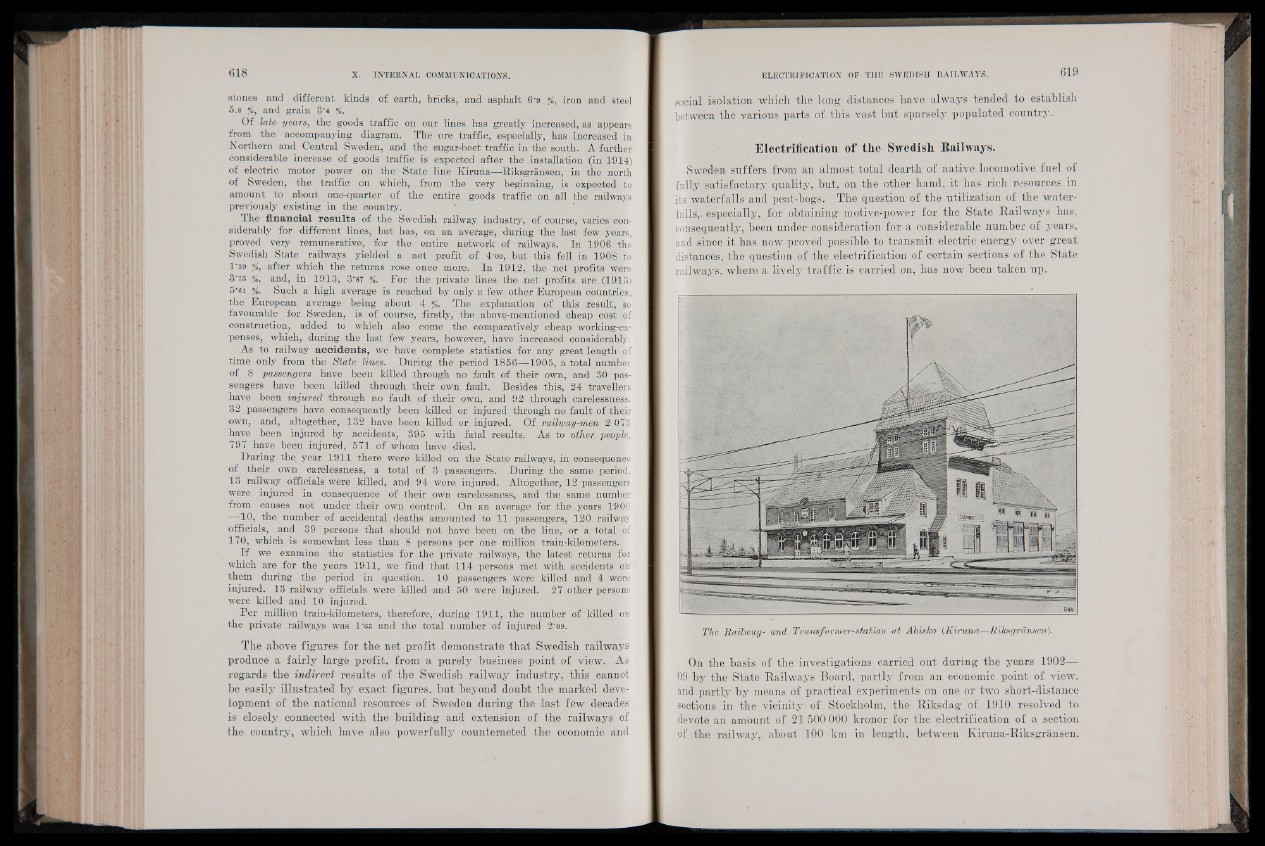
stones and different kinds of earth, bricks, and asphalt 6*9 % iron and steel
5.8 %, and grain 3‘1 %.
Of late years, the goods traffic on our lines has greatly increased, as appears
from the accompanying diagram. The ore traffic) especially, has increased in
Northern and Central Sweden, and the sugar-beet traffic in the south. A further
considerable increase of goods traffic is expected after the installation (in 1914)
of electric motor power on the State line Kiruna—Riksgransen, in the north
of Sweden, the traffic on which, from the very beginning, is expected to
amount to about one-quarter of the entire goods traffic, on all the railways
previously existing in the country.
The financial r e sults of the Swedish railway industry, of course, varies considerably
for different lines, but has, on an average, during the last few years,
proved very remunerative, for the. entire network of railways. In 1906 the
Swedish State railways yielded a net profit of 4"00, but this fell in 1908 |to
l'S8 %, after which the returns rose once more. In 1912, the net profits were
3'73 %, and, in 1913, 3"87 %. For the private lines the net profits are (1913)
5’6i / . Such a high average is reached by only a few other European countries,
the European average being about 4 %. The explanation of this result, so
favourable for Sweden, is of course, firstly, the above-mentioned cheap cost |of
construction, added to which also come the comparatively cheap working-ex-
penses, which, during the last few years, however, have increased considerably.
As to railway accidents, we have complete statistics for any great length fcf
time only from the State lines. During the period 1856—1905, a total number
of 8 passengers have been killed through no fault of their own, and 30 passengers
have been killed through their own fault. Besides this, 24 travellers
have been in ju r ed through no fault of their own, and 92 through carelessness.
32 passengers have consequently been killed or injured through no fault of their
own, and, altogether, 132 have been killed or injured. Of railway-men 2 073
have been injured by accidents, 395 with fatal results. As to other people,
797 have been injured, 571 of whom have died.
During the year 1911 there were killed on the State railways, in consequence
of their own carelessness, a total of 3 passengers. During the same period,
13 railway officials were killed, and 94 were injured. Altogether, 12 passengers
were injured in consequence of their own carelessness, and the same number
from causes not under their own control. On an average for the years 1906
—10, the number of acpidental deaths amounted to 11 passengers, 120 railway
officials, and 39 persons that should not have been on the line, or a "total §>f
170, which is somewhat less than 8 persons p e r. one million train-kilometers.
If we examine the statistics for th e private railways, the latest returns for
which are for the years 1911, we find that 114 persons met with accidents on
them during the period in question. 10 passengers were killed and 4 were
injured. 13 railway officials were killed and 50 were injured. 27 other persons
were killed and 10 injured.
Per million train-kilometers, therefore, during 1911, the number of killed on
the private railways was 1"63 and the total number of injured 2'09.
The above figures for the net profit demonstrate that Swedish railways
produce a fairly large profit, from a purely business point of view. As
regards the indirect results of the Swedish railway industry, this cannot
be easily illustrated by exact figures, but beyond doubt the marked development
of the national resources of Sweden during the last few decades
is closely connected with the building and extension of the railways of
the country, which have also powerfully counteracted the economic and
social isolation which the long distances have always tended to establish
between the various parts of this vast but sparsely populated country.
Electrification of the Swedish Railways.
Sweden suffers from an almost total dearth of native locomotive fuel of
fully satisfactory quality, but, on the other hand, rtrhas rich resources in
its waterfalls and peat-bogs. The question of the utilization of the waterfalls,
especially, for obtaining motive1power for the State Railways has,
consequently, been under -consideration for a considerable number of years,
and since it has now proved possible to transmit electric energy over great
distances, the question of the electrification of certain sections of the State
railways, where a lively traffic is carried on, has now been taken up.
The Railtoay- and Transformer-station at Abisko (Kiruna—Riksgransen).
On the basis, of the investigations carried out duxing the years 1902—
09 by the State Railways Board, partly from an economic point of view,
and partly by means of practical experiments on one or two short-distance
sections in the vicinity of Stockholm, the Riksdag of 1910 resolved to
devote an amount of 21 500 000 kronor for the electrification of a section
of the railway, about 100 km in length, between Kiruna-Riksgransen.